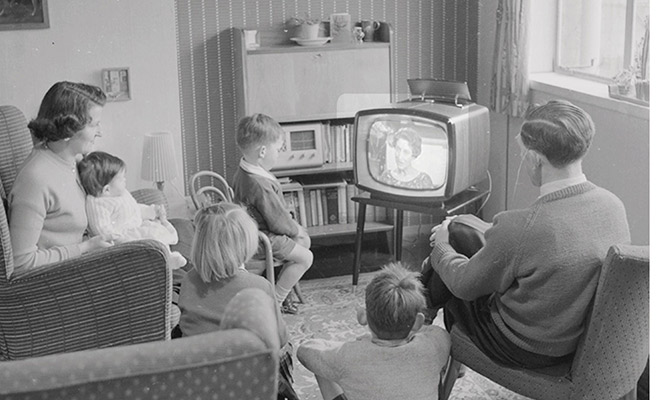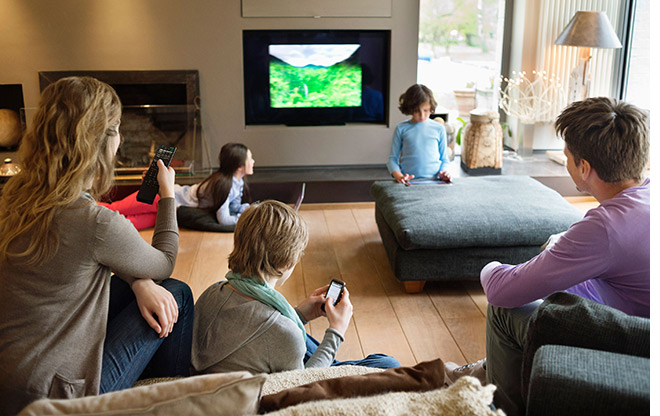Europe's online source of news, data & analysis for professionals involved in packaged media and new delivery technologies

Ofcom's portrait of the British nation - the reinvention of the 1950s living room
The 2013 market report from the UK's communications industries regulator, Ofcom, reveals that people are still coming together to watch TV in the living room - 91% of UK adults view TV on the main set each week, up from 88% in 2002.
However, an increasing array of digital media are now vying for their attention. People are streaming videos, firing off instant messages and updating their social media status - all while watching more TV than before. These activities are mostly carried out using smartphones, with over half of adults (51%) now owning these devices, almost double the proportion two years ago (27%).
At the same time, tablet ownership has more than doubled in the past year, rising from 11% of homes to 24%. The average household now owns more than three types of internet enabled device, with one in five owning six or more.
The digital living room
Over half (53%) of UK adults are now media multi-tasking while watching TV on a weekly basis. Watching other content on a different device is one of these activities.
A quarter (25%) are regularly 'media meshing' - doing something else but related to what they're watching on TV. Examples of media meshing include talking on the phone (16%) or texting (17%) about what they're watching, using social networks (11%) or 'apps' to communicate directly with programmes (3%). Younger people are most likely to use other media while watching TV (74%) with 44% media meshing.
The impact of media meshing was seen during the 2013 Wimbledon Men's tennis final, with 1.1 million people worldwide tweeting 2.6 million times using hashtags associated with the tennis final. Of these tweets, around 80% came from mobile devices.
The other major social phenomenon driven by digital devices is 'media stacking.' Half (49%) of people use their smartphones and tablets for completely unrelated activities while watching TV every week - such as surfing the net (36%), social networking (22%) or online shopping (16%). Women are significantly more likely to media multi-task weekly (56% compared to 51% of men), as are those with children at home (66%).

Television fights back
While the average household owns at least three types of internet-enabled device, the TV set in the living room retains its importance. People are increasingly reverting to having just one TV in their household - 41% of households in 2012 compared with 35% in 2002. In the first quarter of 2013, half (52%) of 5-15 year olds had a TV in their bedroom. This compares to seven in ten (69%) in 2007. And the proportion of UK adults viewing via the main TV set has increased from 88% in 2002 to 91% in 2012.
Live TV accounted for 90% of all viewing in 2012, with the average viewer watching just over four hours of TV a day - 15 minutes more than in 2008. Viewers are also enjoying bigger screens in the living room. 'Jumbo' TV sets (43"+) accounted for 15.8% of sales in the first quarter 2013, a 4.3 percentage point increase on 2012.
Tablets are also supporting the continued popularity of watching TV live, with more than half (57%) of tablet audiovisual content viewers watching live TV at least weekly via this device.
The rising use of tablet computers
Household take-up of tablet computers has more than doubled over the past year, rising from 11% last year to 24% in 2013. Two-thirds of users say they use this device on a daily basis and 95% use it at least once a week. Weekly users say they spend an hour and 45 minutes each day using their tablet.
One in ten (9%) households own more than one tablet and half of owners say they couldn't live without them, up from 34% last year. A third of tablet users say the device is their main way of connecting to the internet - on a par with the laptop.
The growth in ownership of tablets is driving the use of second screens, and enticing people to the main TV room. More than half (56%) of tablet owners use their device for viewing audiovisual content and half of these do so while in the living room.
Furthermore, a fifth of families with a tablet (22%) said they watch different content on different screens while in the same room all or most of the time.
In addition to fuelling media multi-tasking in the living room, among people who watch audio visual content on their tablet, 60% do so in the bedroom. One in ten (11%) watch content in the bathroom, rising to 20% of 18-24 year olds.
More than half (56%) of tablet users watch audiovisual content on the device, while half say they have downloaded at least one TV 'app' such as BBC iPlayer, ITV Player, 4OD, and Demand 5.

The electronic babysitter?
Many parents are using tablet devices to keep their children occupied - three-quarters agree that their tablet is a useful tool for entertaining and educating their children. The majority (91%) of parents with a tablet say their children use it or have one of their own. Two in five (41%) report daily tablet use by their children - 17% say that their children use it more than once a day. TV-type viewing on tablets by children tends to take place in the same room as the main TV or in their bedroom.
Among children, tablet computers are largely used for entertainment purposes. Playing games is most popular (71%), followed by watching short video clips (44%), internet browsing (40%) and watching TV programmes/films (37%). Around one in three parents with a tablet (28%) say that their child uses it for school or college work.
Internet overtakes texting among 16-24 year olds
Web-based forms of communication, such as email, instant messaging or social networking is now the most popular method of communication among younger people. More than eight in ten 16-24 year olds (84%) use at least one of these methods on weekly basis - higher than texting on a mobile phone (80%).
The most popular forms of weekly web-based communication among this age group are social networking (66%) and instant messaging (48%). Individually, each of these methods is used less on a weekly basis than SMS. Around a third (35%) use micro-blogging sites on a weekly basis.
Younger people are also more likely than older users to think it acceptable to share information via text. While 39% of all UK adults think that it acceptable to share good news through public text communication methods - such as posting on open social networking sites - this rises to 61% of 16-24 year olds.
One in five (21%) 16-24 year olds also agree that it is acceptable to start a relationship by text messages, emails or personal messages on social networking sites. Similarly, 30% of 16-24 year olds agree that it is acceptable to have an argument by text.
Superfast broadband rollout gathers pace
Superfast broadband (speeds of over 30 Mbit/s) is now available to almost three-quarters of UK premises. Just under a fifth (17.5%) of all fixed broadband connections were superfast at the end of March 2013, with subscribers doubling from 1.9 million to 3.8 million in the nine months to March 2013.
Thirty per cent of consumers said value for money was the main consideration when selecting their superfast provider. The most notable way users said it had changed their internet use was to increase the amount of TV programmes and full-length films they were streaming. Furthermore, over half of superfast broadband users say they now work at home more than they used to.
Seventy-two per cent of respondents said that they had increased their levels of streaming high-definition content since switching to a superfast service, while 64% had increased streaming of standard-definition content. The same proportion reported increased use of 'cloud' services - where files and content are stored digitally rather than on hardware in the consumer's home.
In 2013, almost eight in ten (79%) superfast broadband users said the download speeds provided by their service had met or exceeded their expectations when they purchased the service.
Of note, over the past five years the average monthly household spend on communications services has fallen from £122.42 in 2007 to £113.51 in 2012. This represents a monthly saving of £8.91, or £106.92 per year.
Data for this annual market research, which Ofcom is required to carry out under the Communications Act of 2003, are based on face-to-face surveys conducted with 3,750 respondents aged 16+ in the UK.
Story filed 04.08.13



















